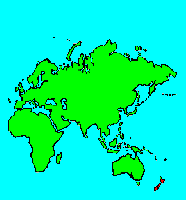SPECIES INFO
South Island oystercatcher (Haematopus longirostris ssp finschi to Haematopus finschi) is found only on South Island New Zealand. Other scientists place this form as a subspecies of Haematopus ostralegus. Consequently, there are three disputed choices: A full species in its own right, a subspecies of longirostris, or a subspecies of H. ostralegus. At any rate, this life form has a black head and neck and upper breast. The middle and lower breast is white. There are two good images of this lifeform on page 17 of the Rosair book on the waders of the world.
In 2003 Howard and Moore listed this as a full species with no subspecies.
The total length is about 18 inches total.Oyster Catchers (Family Haematopodidae) consists of six species of birds with an unusual bill designed to pry oysters loose from rocks along the seashores of the world. Most species are from 16 to 20 inches in length. Some species are generally black with white breasts, and others are primarily all black. Most species have orange or yellow bills. Recently, species divisions have increased the species count to 11 known species one of which is extinct.
Shorebirds (Order Charadriformes) are a group of 305 species of worldwide birds. While good fliers, they are much observed feeding along seashores and in the vicinity of inland bodies of water. Seagulls and sandpipers are typical representatives of this order.
There are many different families herein, and most authors end up with about 18 different families. Other groups included herein include the plovers, curlews, coursers, oyster catchers, jacanas, terns, phalaropes, plovers, stilts and avocets, skimmers, snipes, jaegers, and auks and puffins.
Aves contains about 8,650 different species of living birds known to science. Each year about one new species is discovered in some remote rain forest or remote island. In addition, scientists have been raising many subspecies to full species status which may raise the species count to 10,000. Birdlife recognizes 10,027 species as of 2011.
However, each year about one species goes extinct. The rate of extinction is increasing, and the rate of new discovery is decreasing, so that the number of bird species will soon begin to decline rapidly. Although different taxonomists would organize the birds differently, there are approximately twenty-seven orders of birds. These orders are broken down into about one hundred and fifty-five different families.
Recent research of the genetic structure of some of the shore birds and owls would indicate that the present organization of orders and families should have some modification.
The birds are a worldwide group of animals that are characterized by having the front limbs modified into wings that are used for flying. Perhaps the most unique feature of the birds is the feathers. These feathers are made up of a central support called a quill and a series of small filaments that are hooked together as barbs.
For many years it was believed that Archaeopteryx discovered in Bavaria was the oldest bird from about 150 million years ago. However, in l986, Sankar Chattterjee, a Texas paleontologist, reportedly discovered a bird in the genus Protoavis that lived about 225 million years ago.
When this project was begun in 1978, we used Austin & Singer for bird taxonomy. Since then, we have adopted many changes, but have kept some older concepts that are still found widely in the literature. Recently, we have used Clements and Howard & Moore. Very recently, we have used Monroe and Sibley for the higher taxonomy of the perching birds.
Backboned Animals (Phylum Chordata) are the most advanced group of animals on earth. These animals are characterized by having a spinal cord or backbone. Most members have a clearly defined brain that controls the organism through a spinal cord. Fish, amphibians, reptiles, birds, and mammals are in this phylum.
Currently, some taxonomists believe that the fish should be divided into two groups (sharks and regular fishes) and that there are some other primitive groups in the phylum such as hagfish or lampreys.
Animal Kingdom contains numerous organisms that feed on other animals or plants. Included in the animal kingdom are the lower marine invertebrates such as sponges and corals, the jointed legged animals such as insects and spiders, and the backboned animals such as fish, amphibians, reptiles, birds, and mammals.

